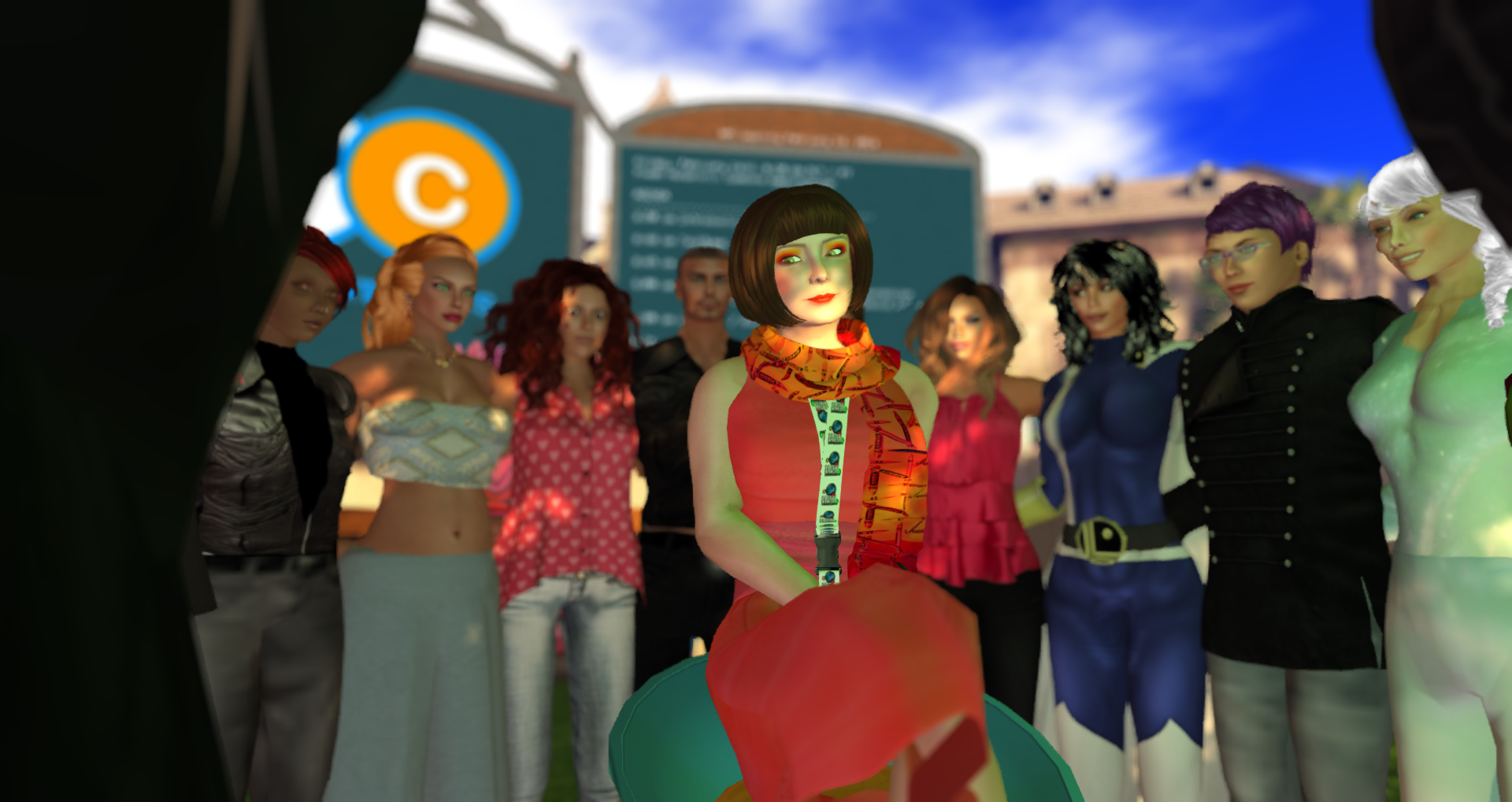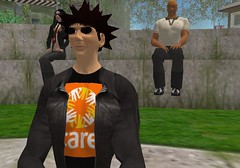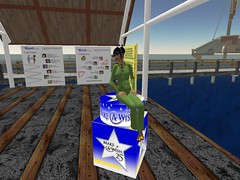
I just came from an historic and ground breaking event. I don’t know if I’m still shaking from the excitement or the hour long multi-tasking frenzy of listening to a live audio feed, seeing a blog.tv stream, reading a chat history, answering ims, and taking notes!
The John D. and Catherine T. MacArthur Foundation hosted its first discussion in Second Life to explore the role that philanthropy might play in virtual worlds. For context, see the event announcement and today’s New York Times article. Jonathan Fanton, above next to my Second Life avatar, engaged in a discussion with Philip Rosedale (Linden) of Linden labs about the role of civil society in virtual worlds and answered questions from the more than 200 avatars that packed the space. (although there was a little bit lag, there was not a major crash and the audio feed was perfect – kudos! to the USC folks)
MacArthur hopes to gain insight into how virtual worlds are used by young people, to introduce the foundation to an audience that may have little exposure to institutional philanthropy and to take part in and stimulate discussions about the real-world issues that it seeks to address.
Here’s a quick summary of my notes:
In Fanton’s welcome, he noted that it is easy to get caught up in the novelty and hype of virtual worlds, but whatever the complexities, "we think they will grow and become integrated into our daily lives." He said that MacArthur hopes to make investments to help nonprofits and civil society organizations address serious issues. They hope to reach out to residents and spark conversations about philanthropic work and to give advice and assistance to residents who want to advance charitable causes.
The discussion started with Fanton and Linden asking questions of each other.
Fanton: "Our first instinct was to create an island and a replica of our office building in Chicago and announce ourselves. We got advice not to do that. We’re trying a year of conversation about how to enter the culture in Second Life and the role of philanthropy. What’s your advice?"
Linden: Second Life is a world being built by the people in it. Faster than real world. A place where individuals are empowered to use relationships and tools to build the world. What I’m seeing – companies and organizations that come in and are successful are those that are able to contribute something to the world itself. Something to make the virtual world better and empowering the community in a unique way.
Fanton: That’s what we are about in the physical world. Foundations don’t do it directly but via nonprofits. If you think about what a foundation has to offer, money for sure, we’re also good at convening people. We’re good at connecting and giving advice. I can imagine a counseling service for young people who are interested in internships. We could make the introduction. We hope that when we enter Second life we can connect and empower.
Fanton: I’ve been reading recently about newspapers and articles that aren’t entirely positive. Can you talk about security and pornography issues?
Linden: You mentioned pornography. Open spaces like the Internet are always going to be about empowerment and you need to have tolerance. I don’t see a way of fixing and I don’t want to fix it. We as the stewards of
this new medium, we should not control people’s choices. Second Life can be the aggregate of public good – we’ll give people the tools what they want to see or not see but not control what people see.
There were some excellent questions from the audience of over 200 gathered in the space.
Here’s a few:
Question: What role do you see MacArthur in building credible information?
Fanton: MacArthur is a knowledge network. We know who is doing the best research. We have to do due diligence in grant making, so we know who to trust. We are a resource bank for people in Second Life who want to know where to get credible information.
Linden: Second Life is building systems for reputation and trust and can go beyond what you can do in the Real World.
Question: What charitable organizations have been successful in Second Life?
Linden gives the example of American Cancer Society.
Closing by Fanton was inspirational:
As MacArthur begins is journey into Second Life, we begin with some assumptions. We assume that people in Second Life are people who care about others and who are open to most communicating across boundaries – both cultural and geographic. People in Second Life have optimism about what can happen and feel a strong desire to come together and work. We hope that together to make the virtual and physical worlds better. MacArthur believes that people who care and have the right information will do the right thing. We have a role to play to work with those of you in Second Life to figure appropriate policy and approaches. How can MacArthur harness the idealism that exists in Second Life?
Rik Riel asked an excellent question and I’m quoting from his notes:
I got to ask Mr Fanton the following question: With a few
exceptions, the philanthropic world has not been very good about
incorporating Web 2.0 tech into their giving practices. What hope do
you have that virtual worlds will be reacted to any differently?
He somewhat dodged the answer, saying that MacArthur wanted to learn
how to work with virtual worlds, to convene people and to bring virtual
projects into making real world change.
Here’s a round up of coverage:
Written by: kanter








